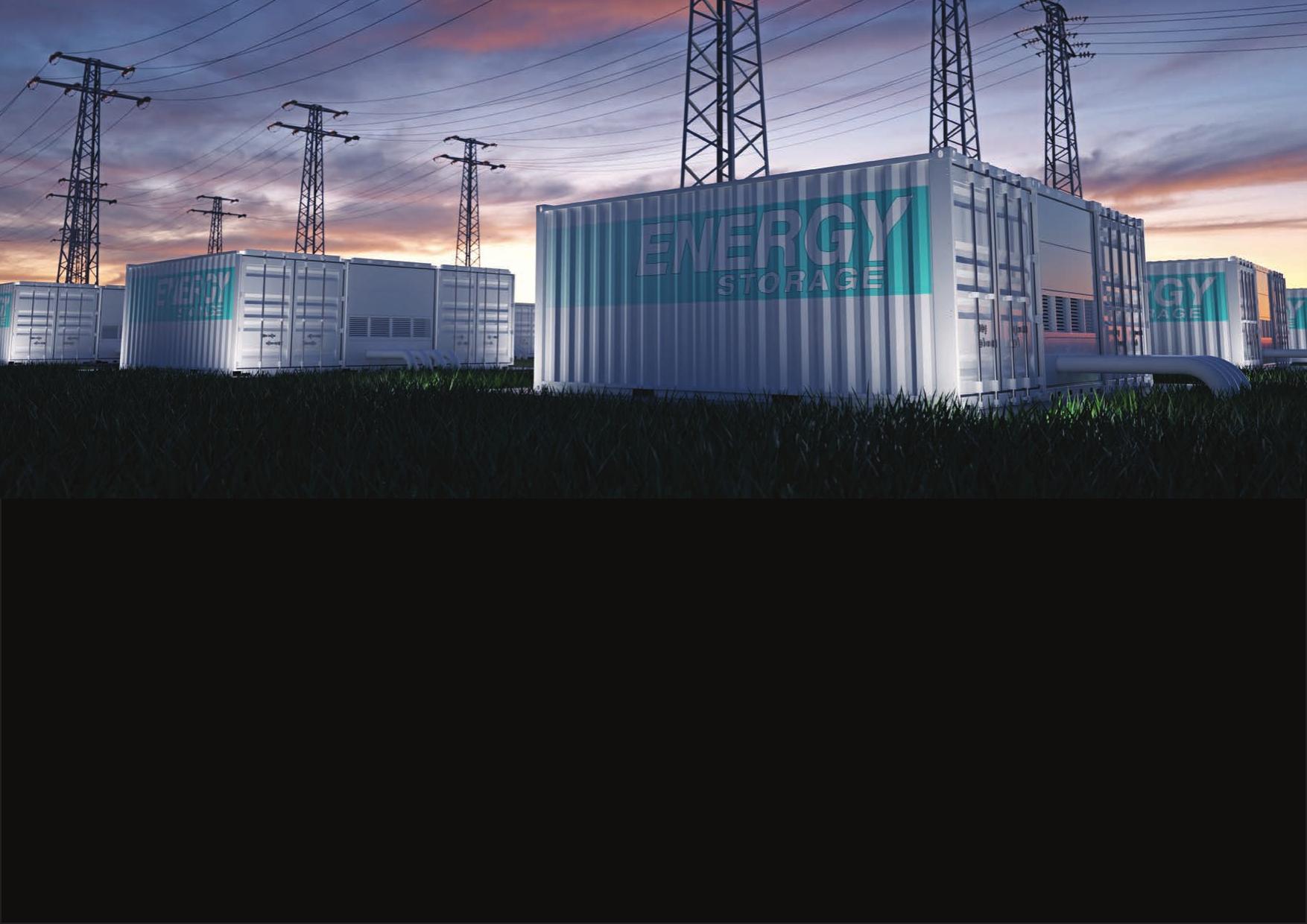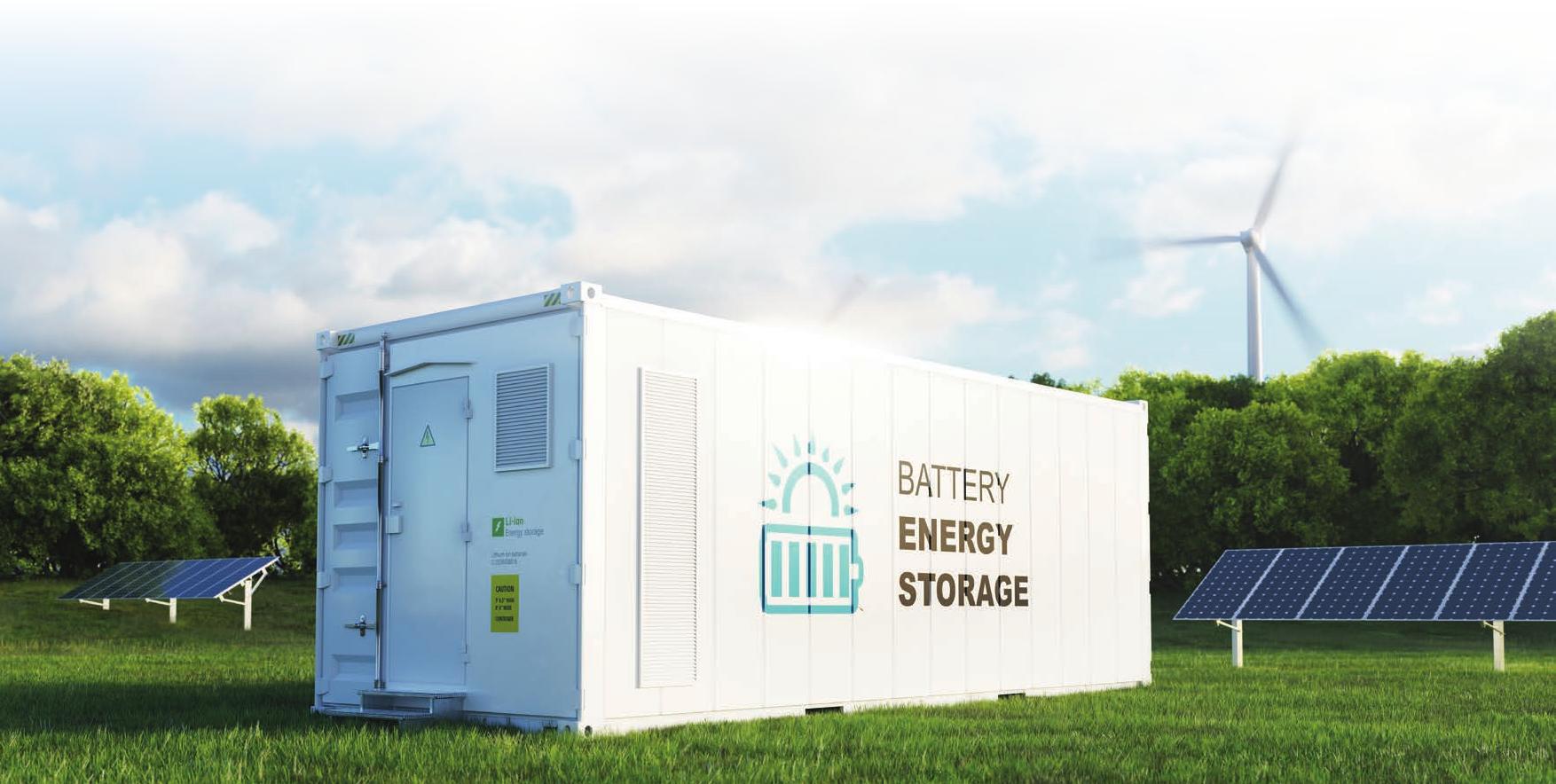StationaryBatteryEnergyStorageSystemsAnalysisAfocusonintradayshiftingMarch2023ContentsPreface3Commercialisationconsiderations10Anoteontheanalysis3Analysis13Summary4Technicalcomparison13Recommendations4Commercialcomparison17Definitions5Environmentalcomparison19Context6Safetycomparison21ExamplesofBESSprojectsandinstallations7Conclusionandrecommendations22Technologiesandmanufacturers8Appendix23Lithiumionbatteries8References25Redoxflowbatteries(RFB)8Moltensaltbatteries9Othermetalbatteries9Non-metalbatteries9PrefaceAnoteontheanalysisThepurposeofthisdocumentistoprovideatechnicalandcommercialTheanalysispresentedinthisdocumentwasconductedinternallybyAraAkeincomparisonofvariousbatteryenergystoragesystem(BESS)chemistrieswhichQ42022,andassuch,onlyshowsasnapshotoftheBESSmarketintime.Duetoarecurrentlyavailableonthemarketsuitableforintradayshifting.thesignificantgrowthandinnovationoccurringintheBESSmarket,dependinguponwhenthisdocumentispickedupbythereader,theresultsthroughoutWhensuchaBESSiscombinedwithanintermittentrenewableenergysystemregardingthechemistriespresentedmaybeoutofdate.withnoinherentstorage(wind,solar,run-of-the-riverhydro),throughouttheday,theresultinghybridsystemcandivertanyexcessenergyproducedattimesoflowdemandtostorage.TheBESScansubsequentlysupplythegridattimesofhighdemand,whilstalsominimisingtheuseoffossilfuelswhenattemptingtomatchpeakdemandandovercomenetworkconstraints.3SummaryRenewableenergyisNewZealand’slargestsourceofelectricitygeneration(82%)•Nickel-hydrogenisdesignedforuptothreecharge/dischargecyclesperday,yetisStationaryBatteryEnergyStorageSystemsAnalysisMarch2023andprovidesapproximately41%ofNewZealand’sprimaryenergysupply.1Ofalsocapableofdischargeratesvaryingbetween2and12hours.Competitorshavetheinstalledrenewableelectricitycapacity,20%isassociatedwithintermittentsimilarcharge/dischargerates,butareonlydesignedforamaximumofonetotworenewableenergysystems(IRES)withlittletonocapacityforenergystorage.2cyclesperdaybeforesignificantlyimpactingbatterylifetime.ThereispotentialtoovercomethisissuebycombiningIRESwithstationaryenergy•Fromacostperspective,nickel-hydrogenisthebestvaluefor12hoursorlessofstoragesystems(i.e.batteries).Withthiskindofhybridsystem,throughintradaystoragewhencomparingthelevelisedcostofstorage(LCOS)ofthetechnologies,shifting,anyexcessenergyproducedbytheplantattimesoflowdemandmaybeameasureofthetotalcostofanenergystoragesystemagainsttheenergystoredtosubsequentlysupplythegridattimesofhighdemand,whilstalsominimisingdischargedoverthebattery’slifetime.theuseoffossilfuelswhenattemptingtomatchpeakdemandandovercomenetworkconstraints.•Theestimatedenvironmentalimpactofthebatteryiscomparabletoanumberofcompetitors,butsignificantlylowerthanlithiumion.AraAkehasidentifiedanumberofpotentialIRESpowerplantswithinNewZealandtodemonstratesuchahybridsystem.Lithiumiontechnologydominatesthebattery•Thenickel-hydrogentechnologyhaspassedallrelevantbatterysafetystandards,marketacrossmostsectors,3includingrenewableenergystorage,butitisofinteresttoincludingtheUL9540Atestforthermalrunaway.ManynewbatterytechnologiesAraAketounderstandthetechnicalandcommercialcharacteristicsofallthevarioushavepassedthistest,however,fewlithiumionmanufacturershavewithonlyasinglebatterysolutionsavailableonthemarket,aswellasthesafetyandenvironmentalcontainerisedlithiumionbatterymanufacturerintheUL9540Adatabase(EVLO).impactsofthesetechnologies.•Themanufacturer,EnerVenue,hasbeenbackedbymultibilliondollarengineeringRecommendationscompany,Schlumberger(marketedasSLB),whowillsupportlarge-scaledeploymentofnickel-hydrogenbatterytechnologyacrossselectedglobalmarkets.CurrentOfthemorethan10containerisedBESSstudied,nickel-hydrogen(NiH2)isastandoutproductionvolumeis60MWh/year,howeverplannedfacilitiessoontobeunderchemistryforstorageof12hoursorlesswhenconsideringallaspectsduetoauseableconstructionwillresultinexceeding2GWh/yearbytheendof2024.lifetimeof30yearsand30,000charge/dischargecycles.Anotherbatterytechnologywhichcouldbeofinterestiscalcium-antimony•Onafootprintbasis,nickel-hydrogeniscompetitiveintermsofuseableannual(CaSb),givenitshighenergyoutputandlowLCOSsimilartonickel-hydrogen.energyoutputwithhigherenergydensitylithiumionandmoltensaltbatteryNoenvironmentaldataforthistechnologywasavailable,butallthingsconsidered,chemistries.Onalifetimebasis,nickel-hydrogenhasamongthehighestenergyitcouldbeaninterestingtechnologyforsimilarapplications.outputofalltechnologiesstudied,beatingallmanufacturers,buttwolithiumionofferings(CATLandTesla).4DefinitionsElectricalcurrent(A)Ratedpoweroutput(kW)C-rating(hours-1)StationaryBatteryEnergyStorageSystemsAnalysisMarch2023Theflow(andamount)ofelectricityinanelectricalThetheoreticalmaximumamountofinstantaneousThecharge/dischargerateisameasureofhowmuchcircuit,measuredinamperes.1Aisequaltoanelectricalpower,measuredinkilowatts,whichcanflowintoorouttimeisrequiredtofullychargeordischargeabattery.flowrateof6.241509074×10¹⁸electronspersecond.ofabattery.NotethattheC-ratingofabatteryimpactspoweroutpute.g.a120kWhbatterywithaC/2ratingwillElectricalresistance(Ω)Ratedbatterycapacityorenergyoutput(kWh)provide60kWofpowerover2hours.AC/12equivalentwouldprovide10kWover12hours.Theoppositiontoflowofelectricalcurrentinacircuit,AtheoreticalmeasureofbatterypowerdeliveredovermeasuredinOhms.agiventimeperiodi.e.1kWhisequivalentto1kWofBatterycycleconstantpowerovertheperiodof1hour.1kWhisalsoVoltage(V)equivalentto3.6megajoules(MJ).Theprocessofchargingabatteryanddischargingitasrequired.AsinglechargeanddischargeisequivalentTheelectromotivedrivingforceinanelectricalcircuit,Roundtripefficiency(%)to1cycle.measuredinVolts.Voltageistheproductofcurrentandresistance.ThepercentageofenergyusedtochargethebatteryLifetimedegradation(%/lifetime)(i.e.putintostorage)whichcanthenbelaterretrieved.Electricalpower(W)ThisisessentiallyameasureoftheenergylostduringAprocesswhichpermanentlyreducestheamountofagivencharge-dischargecycle.energyabatterycanstore,ortheamountofpoweritTherateelectricalenergyistransferredbyanelectricalcandeliver.Usuallypresentedonapercycleorpercircuit,measuredinwatts.PoweristheproductofUseablebatterycapacity(kWh)yearbasis.voltageandcurrent.TheactualbatterypowerdeliveredoveragiventimeBatterylifetime(yearsorcycles)Batteryperiod,onceaccountingforroundtripefficiency.BatterylifetimeisequivalenttothenumberofcyclesAdevicecontaininganelectriccelloraseriesofbeforethebatterywilleithernolongerholdchargeorelectriccellsstoringenergythatcanbeconvertedintoperformanceissignificantlyreduced.Thislifetimemayelectricalpower.alsobeconvertedtoyears.5ContextStationaryBatteryEnergyStorageSystemsAnalysisMarch2023RenewableenergyisNewZealand’slargestsourceofelectricitygeneration(82%)andprovidesapproximately41%ofNewZealand’sprimaryenergysupply.1Ofthe7682MWofrenewableelectricitycapacityinstalledinNewZealandbytheendof2021,1703MWaregeneratedbyintermittentrenewableenergysystems(IRES).2Suchsystemsinclude:•Run-of-theriverhydropower(586MW),3whereelectricityisgeneratedfromwaterflowinginariverorstream(asopposedtoconventionalhydrowhichgeneratespowerfromthegravitationalpotentialenergyofdammedwater)†;•Wind(913MW),whereturbinesgenerateelectricityfromthewind’skineticenergy;and•Solar(205MW),wherephotovoltaic(PV)cellsconvertsunlightintoelectricalenergy.Thekeydifferencebetweentheabovesystemsandconventionalhydropowerandgeothermalplantsisthattheyhavelittletonocapacityforenergystorageandaresubjecttoambientconditionssuchasseasonalriverflow,windspeed/directionandsolarradiation.Thismakestheseplants’electricitysupplyirregularwiththeinabilitytoco-ordinateelectricaloutputwithconsumerdemand.ThereispotentialtoovercomethisissuebycombiningIRESwithstationaryenergystoragesystems(i.e.batteries).Withthiskindofhybridsystem,throughintradayshifting,anyexcessenergyproducedbythepowerplantattimesoflowdemandmaybestoredtosubsequentlysupplythegridattimesofhighdemand.Havingaccesstothisstoredrenewableenergywillminimisetheuseoffossilfuelswhenmeetingpeakdemandandalsohasthepotentialtoprovidemoreeffectiveembeddedgeneration,tomatchpeakloadandnetworkconstraints.AraAkehasidentifiedanumberofpotentialIRESpowerplantswithinNewZealandtodemonstratesuchahybridsystemtosupportintradaygenerationshiftingandlinescompanyconstraintmanagement.Lithiumiontechnologydominatesthebatterymarketacrossmostsectors4,includingrenewableenergystorage,butitisofinteresttoAraAketounderstandthetechnicalandcommercialcharacteristicsofallthevariousbatterysolutionsavailableonthemarket,aswellasthesafetyandenvironmentalimpactsofthesetechnologies.†ThereisanargumentthatanumberofNewZealand’slargeconventionalhydroelectricplantsareessentiallyrun-of-the-riverbecauseoftheirlimitedstorage,howeveradistinctionismadethatiftheriverisimpoundedtocreateareservoirofsignificantsizethentheplantistechnicallynotrun-of-the-river.56ExamplesofBESSprojectsandinstallationsBytheendof2021,theinstalledcapacityofgrid-scaleBESSaroundtheworld•InJanuary2023,RWE,aGermanenergyprovider,commissioned117MW,128MWhexceeded16GWandglobalinvestmentsapproached$10billionUSD6.Somerecentoflithiumionbatteriesacrosstwooftheirrun-of-the-riverplants.10ThesystemsexamplesofbothdomesticandinternationalrenewableenergybatterystorageatGersteinwerkinWerneandEmslandstationinLingenhaveenergycapacitieshybridprojectsinclude:of79MWhand49MWhrespectively.Throughtheseinstallations,RWEcanmakeadditionalelectricitycapacityavailabletothegridandalsobalancetheflowofenergy•InMarch2022,WELNetworksandInfratecannouncedthattheyhadenteredintofromthepowerstations,helpingtokeepthefrequencyofthepowergridstable.majorcontractsforthesupplyandbuildofNewZealand’sfirstrenewableenergyBESShybrid7.Alongwiththeproposedbatteryfacility,consistingofa35MW•NewZealandgentailer,MeridianEnergy,announcedinDecember2022thatlithiumionunitfromSAFT,anewsolarfarmisbeingexploredtoreducethecostofconstructionoftheRuakākāBESSatMarsdenPointwillbegininQ12023.11Uponrenewablepowerforconsumers.ConstructionbeganinAugust2022and,oncecompletionandcommissioning(expectedH22024),the100MW,200MWhSAFTcommissioned,thefacilitywillstoreenoughenergytomeetthedailydemandsoflithiumionunitwillbehybridisedwithanew130MWsolarPVplanttoreducecosts.12over2,000homesandwillbecapableofprovidingfastreservessupportfortheNorthIslandgrid.•PortlandGeneralElectriccommissionedtheUnitedStates’firstfacilitytoco-locatewindandsolargeneration,coupledwithbatterystorage,inSeptember2022.13The•AESChilesubmittedanEnvironmentalImpactAssessmentinlateFebruary2023WheatridgeRenewableEnergyFacilityhasa300MWwindfarm,a120MWsolarforan$800MUSDhybridparkintheAntofagastaregion.Theprojectwillinvolvefarmanda120MWhlithiumionBESS.Atmaximumoutput,thefacilitylocatedneartheconstructionofa140MWwindfarm,252MWofsolaranda623.5MW,3,100MWhLexington,OregonproducesmorethanhalfofthepowerthatwasgeneratedbylithiumionBESS8.ThisproposedBESShybridfollowsonfromthe2019installationOregon’slastcoalplant(demolishedthesamemonththisfacilitybecameoperational)ofa10MW,50MWhlithiumionenergystoragesystematits178MWhrun-of-the-riverorenoughemissions-freeenergytopowerabout100,000homes.14hydropowerfacilityattheCordilleraComplexnearSantiago,Chile.Priortothis2019installation,AESChile(thenAESGener)conductedananalysisonarangeofstorageTheexampleslistedherereflectthatlithiumionbatterystoragecurrentlyexhibitsaoptions,finallychoosinglithiumionbatteriesbecausethetechnologyisscalingcleardominanceintherechargeablebatterymarket,accountingformorethan90%ofexponentiallyandwasmostfavourableintheirassessmentwhenconsideringfactorsallBESSdeploymentsinboth2020and2021.6Thisdominancehoweverislikelydueincludingcost,safety,energydensity,charginganddischargingrates,andoveralltoavarietyoffactors,suchasmanufacturingcapability,asmanynewertechnologieslifecycle.9capableofcompetingwithlithiumiononatechnicalandcommercialleveldonotyethavethemanufacturingcapacitytosupplylargeMW-scaleenergystoragesystems.7TechnologiesandmanufacturersAnanalysishasbeenconductedonstationary,longdurationbatterysolutionsRedoxflowbatteries(RFB)StationaryBatteryEnergyStorageSystemsAnalysisMarch2023suitableforapplicationtointermittentrenewableenergysystems.InRFBs,redox(reductionandoxidation)reactionswithinelectrochemicalcellsenablesAtypical20ftcontainerisedBESSproducinggreaterthan100kWhofenergy,overenergytobestoredinaflowingliquidelectrolytesolutionduringbatterychargeand12hoursorless,hasbeenusedasabaselineforthisanalysis,soonlyperceiveddischarge.Batterypowerisdependentuponthesizeoftheelectrochemicalstack,competitorstosuchaproducthavebeenincluded.whereasbatteryenergydependsuponthevolumeofelectrolyte.ThisseparationofpowerandenergyisakeydistinctionandadvantageofRFBswhencomparedtoThebatterysolutionsandmanufacturerswhichhavebeenidentifiedaredetailedintheotherelectrochemicalstoragesystemsassystemvulnerabilitytouncontrolledenergysubsequentsection.Althoughidentifiedhere,somecompaniesassociatedwiththereleaseislimitedbysystemarchitecturetoafewpercentofthetotalenergystored.22technologiesofinterestdonotprovidesufficientinformationtoallowforanykindofanalyticalcomparisonbetweenproductsandthereforehavenotbeenincludedintheVanadium(VRFB)analysis.•CellCube23•InvintyEnergySystems24Lithiumionbatteries•RongkePower25•VRBEnergy26Lithiumionbatteriesutilisesolidelectrodesoftypicallycarbonandmetaloxidewithaliquidorganicelectrolytecontainingadissolvedmetalsalt.MetalionstravelbetweenZinc-Bromide(ZnBr2flow)electrodesviaaporousmembrane,generatinganelectricalcurrent.15Thetwomost•Redflow27commonchemistriesarelithiumironphosphate(LFP)andnickelmanganesecolbolt(NMC).ManufacturersaremovingmoretowardstheformerasdespiteNMCtypicallyZinc-Airhavingahigherenergydensity,LFPischeapertoproduce,hasalongerlifecycleand•Zinc828islesssusceptibletothermalrunaway.Ironflow(IFB)Lithiumion•ESS29•CATL16•CorvusEnergy17Organic(non-metal)•Eaton18•CERQ(formerlyJenaBatteries)30•EVLO19•SAFT20•Tesla218MoltensaltbatteriesZinc-Bromide(ZnBr2non-flow)Typicallyaredoxflowbatterychemistry,oxidationreductionchemistryoccursbetweenThesebatteriesoperatewellinexcessof1000Candtheanodeandcathodearezincandbromideelectrodesviaeitherasolidgeloraqueouselectrolyteallowingzinctypicallyliquidseparatedbyasaltelectrolyteorceramicmembranecapableofionstoflowthroughamembrane,subsequentlygeneratingcurrent.conductingmetalionstogenerateanelectricalcurrent.•EOSEnergyEnterprises36•Gelion37Calcium-Antimony(CaSb)•Ambri31Lead(Pb)Interestingly,nolead-basedbatterieshavebeenidentifiedinthisparticularspace,Sodium-Nickel-Chloride(NaNiCl2)likelyduetothechemistry’slowenergydensity,shortlifetimeand,asaresult,high•FZSoNick32pricewhencomparedtolithium-ion,thedominantchemistryintoday’sbatterymarket.SodiumSulphur(NaS)Non-metalbatteries•NGKInsulators33ConductivepolymerOthermetalbatteriesSolidcarbon-graphenehybridelectrodescombinedwithaliquidelectrolyteandapermeableseparatingmembraneenableionstotravelbetweentheanodeandNickel-Hydrogen(NiH2)cathode,creatingelectricalcurrent.Nickelhydroxideandnickelalloyelectrodesinthepresenceofanalkalineelectrolyte•PolyJoule38createanelectricalcharge,producingandconsuminghydrogengasonchargeanddischarge.•SLB(partneredwithEnerVenue)34,359CommercialisationconsiderationsTheprevioussectiondetailsasubsetoftheplayersinthestationaryBESSmarket,Figure1:TechnologyReadinessLevel(IEA)howeveranimportantdiscussionpointbeyondthechemistryishowfarthroughthecommercialisationjourneyareeachofthesechemistriesand/orcompanies.StationaryBatteryEnergyStorageSystemsAnalysisMarch2023Table1detailsanumberofkeycommercialisationmetricswhichhavebeenidentifiedacrossthemanufacturerslistedintheprevioussection.Thesemetricsincludeyearfounded,installedbatteryvolume(inMWh),numberofemployees,revenue(in$MUSD,ifany),annualproductionvolumeandtotalagreedprojectpipeline(bothinMWh).SomeimportantthingstonoteisthatanumberofthesecompanieshavebusinessinterestsoutsideofstationaryBESS,sothenumberspresentedmaynotnecessarilybeadirectresultoftheiractivitiesrelatedtoBESS.Also,althoughtheremaybeasignificantdifferenceinsomevaluespresentedwhencomparedtoothermanufacturers,thisdoesnotnecessarilymeanthattheyareatdifferentstagesofcommercialisation,itmaysimplyreflectothermarketindicatorssuchasmarketshare(i.e.twoBESScompanieswith200and2000employeesmaybesimilarlycommercialisedwithinthemarket.Athirdcompanywith20employeesislikelysignificantlylesscommercialised).Nevertheless,themetricspresentedprovidereasonableproxiestoindicateacompany’sstageofcommercialisation.Similarlytotheprevioussection,althoughidentified,somecompaniesassociatedwiththetechnologiesofinterestdonotprovidesufficientcommercialinformationinthepublicdomaintoallowforanykindofanalyticalcomparisonbetweenproductsandthereforehavenotbeenincluded.Inthemajorityofcases,eachcompanypresenteddoesnotdetaileachandeverymetricofinterestinthepublicdomain,howevertheydoprovideenoughtomakeaneducatedcomparison.Estimatesofcommercialisationstagemaybemappedagainstthe11-pointtechnologyreadinesslevel(TRL)scalepresentedbytheInternationalEnergyAgency(seeFigure1).3910TherangewhichisrelevanttothemanufacturersincludedisestimatedtobeTRL7toSometakeawaysfromthisTRLmappinginclude:StationaryBatteryEnergyStorageSystemsAnalysisMarch2023TRL11,pre-commercialdemonstrationtomatureinmarket:•Oldertechnologies,withfewerrecentdevelopments,suchaslithiumion,vanadiumTRL11:Matureinmarket(verylargeproductvolumesmanufactured,deliveredandflowandmoltensodiumbatteriesarehigheruptheTRLscale.demonstratedinfieldi.e.>1GWh,revenuelikely>$50MUSD)•CATL•Ofthenewertechnologies,EOSEnergyEnterprises(non-flowzinc-bromide)appears•CorvusEnergytohaveasignificantcommercialadvantageoveritscompetitors,generatingover•NGKInsulators$10MUSDinrevenuein2022withatleasta1.8GWhprojectpipeline.•RongkePower•SAFT•CompanieslowerontheTRLscale(TRL7-8)willhaveasignificantnumberof•Teslacommercialisationbarriers(forexample,manufacturingandsupplychain)tocrossbeforegainingearlyadoptioninthemarket.ThiswillbesignificantlymoreTRL10:Earlyadoptioninmarket(largeproductvolumesmanufactured,deliveredandchallengingforindependentcompanieswhencomparedto,forexample,EnerVenuedemonstratedinfieldi.e.100MWh-1GWh,revenuelikely$10M-$50MUSD)(nickel-hydrogen),whohavebackingfromglobal,multibilliondollarengineering•CellCubecompany,Schlumberger(nowmarketedasSLB).•EOSEnergyEnterprises•FZSoNick(acquiredbyHitachiChemical-$5.8BUSDrevenuein2021)TRL9:Commercialoperation(significantproductvolumesmanufactured,deliveredanddemonstratedinfieldi.e.10MWh-100MWh,revenuelikely$1M-$10MUSD)•InvintyEnergySystems•VRBEnergyTRL8:Commercialdemonstration(smallproductvolumesunderdemonstrationwithsignificantgrowthinmanufacturingi.e.1MWh-10MWh,revenuelikely$100K-$1MUSD)•Ambri•EnerVenue(globallybrandedasSLB-$28.1BUSDrevenuein2022)•ESS•RedflowTRL7:Pre-commercialdemonstration(onlysmallproductvolumesmanufactured,deliveredanddemonstratedinfield,minimalorpre-revenue)•Gelion•PolyJoule•Zinc811Table1:CommercialmetricsofbatterymanufacturersChemistryManufacturerFoundedDispatchedvolumeEmployeesRevenueProductionvolumePipelinevolumeYearMWh#$MUSD/yearMWh/yearMWhApprox.170,000CATL2011-33,00014,36440(Additional140,000per-yearunderconstruction)CorvusEnergy200940019261>1,000-SAFT1918Lithiumion(2020)41780170,000->4,000(58MforBESS)42(Totalplannedproduction-by2025)Tesla2003>17,000128,00081,46240,000(Megapackonly)-(10,000non-automotive)43CellCube200842.9614.09(2019)44--VanadiumInvintyEnergySystems202028.01713.245-66.3RongkePower2008992--300-VRBEnergy2007>3065-->500EOSEnergyStorage200864025018.4800>1,800Gelion2015Pilotscale#500.43462-StationaryBatteryEnergyStorageSystemsAnalysisMarch20231.1247Zinc-basedRedflow2005>26280-Zinc82011Pilotscale440(Goaltogenerate1(Ambitionof60MWh-by2024)48by2024)Sodium-basedFZSoNick49201140013032.2(2019)50100-NGKInsulators5119194,10020,10040411,000-IronflowESS2011-1830.8752750>12,00053Calcium-AntimonyAmbri2010Commercialpilot#122-200(200,000cellsby>1,20054endof2023)Nickel-HydrogenEnerVenue(SLB)2020Commercialpilot110-60(2,200plannedby>5,000552024;31,000by2027)OrganicPolyJoule2011Pilotscale11->1(10000cells)<1RevenuedatahasbeengainedfromGoogleFinanceQ32021toQ32022,unlessspecifiedotherwise.Unknowndatanotavailableinthepublicdomainhasbeenindicatedwithadash.#Pilotscalereferstoinstallationslessthan1MWh.Commercialpilotreferstoinstallationsbetween1–2MWh.12AnalysisThedatapresentedinthissectioniseitherpubliclyavailableorhasbeengainedFigure2:Effectiveenergydensityofbatterytechnologiesthroughdirectconsultationwiththemanufacturer.Forthosetechnologieswithmultipleplayers(i.e.lithiumionandvanadiumflow),batterydatahasbeen150aggregatedandaveragevaluesarepresented.Theraw,non-aggregateddataisprovidedintablesintheAppendix.Effectiveenergydensity(kWh/m2)100TechnicalcomparisonStationaryBatteryEnergyStorageSystemsAnalysisMarch202350Effectiveenergydensity0Theenergydensityofbatteriesistypicallypresentedinwatt-hourspergram(Wh/g-AntonylymerflowIonrogenlorideSulphurflowlow)-flow)orkWh/kg).ThisprovidesareasonablecomparisonwhentheuseableenergylciumimIronhiuml-Hydel-Chum-adiumide(F(Nonoutputandweightofthebatteryisknown,however,inthecaseofcontainerisedvePomenergystoragesystems,thereissignificantvoidagewithinthecontainerforthenductiLitke-NickSodiVanc-Broomidepurposeofmaintenance,airflowetc.ThismeansthatonlyaneffectiveenergydensitycanbedeterminedusingtheuseableenergyoutputandtheweightoftheCaCoNicSodiumZinZinc-Brcontainerisedsystem.Thisapproachisalsochallengingassomemanufacturersdonotprovidetheweightofthecontainerisedsystem,however,allprovidetheareafootprintofthesystemforagivenenergyoutput,enablinganeffectiveenergydensityofkWh/m2tobepresentedinFigure2.Notethatanadvantageofcontainerisedsystemsisthattheymaybestacked,however,forthepurposeofthiscomparison,thefootprintdensityhasonlybeenpresentedforasystemwithasinglecontainer.Lithiumionhasthehighestaverageenergydensityofthetechnologiescomparedatapproximately145kWh/m2.Thisobservationisnotsurprisingaslithiumionisknownforhavingaparticularlyhighenergydensitywhencomparedtootherrenewablebatterytechnologies.56Thisisthenfollowedbymolten-saltbatteries(calcium-antimony,sodium-nickel-chloride,sodium-sulphur),whicharealsoknownforhighenergydensities,57atapproximately80kWh/m2.Zinc-brominetechnology,inbothflowandnon-flowbatteryconfigurations,hasaneffectiveenergydensityof30kWh/m2.Thisdensityissimilartonickel-hydrogen(25kWh/m2),butmuchhigherthanotherflowchemistries(Vanadium,10kWh/m2;Iron,15kWh/m2).Duetoitsearlystageofdevelopment,theconductivepolymerbatteryhasalowenergydensityof15kWh/m2,similartoverylargeredoxflowsystems.13Batterycyclingnickel-hydrogentechnology(>1000MWh/m2-lifetime)whilstthefourremaininglithiumStationaryBatteryEnergyStorageSystemsAnalysisMarch2023ionproductshaveoutputsoflessthan650MWh/m2-lifetime.Thelifetimeofabatteryismeasuredbythetotalnumberofcharge/dischargecyclesabatterycanachievebefore:Onanannualbasis,duetohavinghighenergydensities,lithiumionhasthehighestenergyoutput(43MWh/m2-year,aggregated;76MWh/m2-year,Tesla),followedby•Thebatterycannolongerholdacharge;orthemoltensaltcalcium-antimonybattery(30MWh/m2-year).Interestingly,despitehavingarelativelylowenergydensity,nickel-hydrogenhasthethirdhighestoutputof•Significantenergycapacitydegradationhasoccurred.24MWh/m2-year(jointwithsodium-nickel-chloridemoltensalttechnology)duetothetechnology’scapabilitytocyclethreetimesperday.Ofthebatterytechnologiesinvestigated(seeFigure3),nickel-hydrogeniscapableofachievingatleast30,000cyclesinitslifetime.ThisisfollowedbyvanadiumandOthertechnologieshavespecificenergyoutputsgenerallylessthan350MWh/m2-ironredoxflowbatterieswithlifetimesofapproximately20,000cycles.Allotherlifetimeand20MWh/m2-year.technologieshaveatheoreticallifetimelessthan12,000cycles,withthemajoritylessthan7,000cycles.C-ratingForthisresearch,itisofparticularinteresttounderstandwhichbatterytechnologyisTheC-ratingorcharge/dischargerateisameasureofthespeedtofullychargeorsuitableformultiplecyclesonagivenday.Somebatterymanufacturersstatethattheirdischargeabattery.technologyiscapableofanunlimitednumberofdailycyclesdespitestatingaverylonglifetimeinyears(whichdoesnotalignwiththetheoreticalcyclelifetime).AsaThisisanimportantmeasurementwhenconsideringbatterytechnologiesforIRES,result,somebatterytechnologiescapableofmultiplecyclingperdayareonlyabletoaslongdurationenergystorageisofparticularinterestduetothepotentialtomeetdosobysignificantlydecreasingtheyearsofuseablebatterylife.peakdemandoverextendedperiodsusingstoredrenewablepowerratherthanfossilfuels.58Toconductafaircomparison,theannualcyclesofagiventechnologyhasbeendeterminedbydividingthetheoreticalcyclelifeofthebatterybythedesignlifetime,ThedefinitionoflongdurationenergystorageorLDESvariesbysource.Typically,itisinyears.AsshownonFigure3,duetoitsdesignlifeof30years,nickel-hydrogenenergystorageforgreaterthanfourhours(i.e.C/4).59Thisextendstogreaterthan10technologyisagaindominantwithadesignof1000cyclesperyear(orapproximatelyhours(C/10)asperthedefinitionsetbytheUSDepartmentofEnergy.60threecyclesperday).Similarly,largeredoxflowsystems(vanadiumandiron)arecapableofapproximately800cyclesperyear,followedbyconductivepolymerat600Figure5presentstheinverseC-rating,i.e.thecharge/dischargeduration,foreachcyclesperyear(approximatelytwocyclesperday).Allotherbatterytechnologies,batterytechnology.Alltechnologiesexceptlithiumionhaveacharge/dischargeratebasedupontheirtheoreticalcycleandyearlylifetimes,arecapableofonecyclemuchgreaterthanfourhours.Thisisconsistentwhenincreasingthecharge/dischargeperday.rateto10hours,withonlysodium-nickel-chloride(andlithiumion)fallingbelowthislevel.SpecificenergyoutputAmbienttemperaturerangeThetotalspecificenergyoutputofeachbatterytechnology,onbothanannualandlifetimebasis,canbedeterminedthroughcombiningtheeffectiveenergydensitywithFigure6presentstheoperatingambienttemperaturerangeofeachbatterythenumberoftheoreticalannualandlifetimecharge/dischargecycles(seeFigure4).technology.AlltechnologiescanoperatewithinNewZealand’smeantemperaturerangeandatextrememaximumtemperatures.61Onlycalcium-antimony,nickel-Whenaccountingforlifetimedegradation,nickel-hydrogenhasthehighestspecifichydrogen,sodium-nickel-chlorideandconductivepolymerchemistriescanoperateatenergyoutputoveritslifetime(720MWh/m2-lifetime)whencomparedtotheNZ’sextrememinimumtemperatures.aggregatedlithiumionlifetimeoutput(710MWh/m2-lifetime)andtheoutputoftheotherhighenergydensitytechnologies(600MWh/m2-lifetime,calcium-antimony).ThisisImportantly,irrespectiveofambienttemperature,themajorityoflithiumionbatteryduetothetechnology’sveryhighcyclelifetimeandlowdegradationrate(0.2%/yearsystemsrequirecoolingsystemstopreventthermalrunaway.comparedto2%+forlithiumion).Itisnotablehoweverthattwoofthesixlithiumionproductsanalysed(CATLandTesla)havelifetimeenergyoutputsexceedingthatofthe14Figure3:LifetimeandannualcyclingofbatterytechnologiesFigure4:AnnualandlifetimespecificenergyoutputofbatterytechnologiesLifetimecyclesAnnualcyclesLifetimeEnergyAnnualEnergy503500012008003000010004060025000LifetimecyclesAnnualcycles800Lifetimespecificenergyoutput(MWh/m2-lifetime)Annualspecificenergyoutput(MWh/m2-year)StationaryBatteryEnergyStorageSystemsAnalysisMarch202330200006004001500020400100002001020050000000onylymerflowIonrogenloridelphurflow(Flow)-flow)onylymerflowIonrogenloridelphurflow(Flow)-flow)imIronm(NonimIronm(Non-AnttivePohiul-Hydel-Chum-Suadiummide-AnttivePohiul-Hydel-Chum-SuadiummidemLitNicke-NickSodiVanc-BroomidemLitNicke-NickSodiVanc-BroomidelciunduclciunducCaCoSodiumZinZinc-BrCaCoSodiumZinZinc-Br15Figure5:Charge/dischargedurationofbatterytechnologiesZinc-Bromide(Non-flow)Zinc-Bromide(Flow)VanadiumflowSodium-SulphurSodium-Nickel-ChlorideNickel-HydrogenLithiumIonIronflowConductivePolymerCalcium-Antimony135791113HoursFigure6:OperatingambienttemperaturesofbatterytechnologiesNZextremesrangeNZmeanrangeZinc-Bromide(Non-flow)StationaryBatteryEnergyStorageSystemsAnalysisMarch2023Zinc-Bromide(Flow)VanadiumflowSodium-SulphurSodium-Nickel-ChlorideNickel-HydrogenLithiumIonIronflowConductivePolymerCalcium-Antimony-60-40-20020406080100Temperature(0C)16CommercialcomparisonFigure7detailstheLCOSforbatterysystemsagainsttotalstorageduration,assuming300and600cyclesperyear(approximatelyoneandtwocyclesperday).LevelisedcostofstorageInsightsfromthefiguresaresummarisedbelow:Ofthemanufacturerswithinthisanalysis,fewprovidenumericalinsightintothecostoftheirenergystoragesystemsbeyondpresentingonlyfavourabledatafromaOnecycleperday:marketingperspective.•Lithiumionbatteries,operatingatonecycleperday,startatapproximatelyInordertoeffectivelycomparethecostofenergystoragesystems,acalculation$400(±40)/MWhforonehourofstorage,reducingto$280(±20)/MWhfor4-12hoursknownasthelevelisedcostofstorage(LCOS)isutilisedtoquantifythediscountedofstorage.costperunitofdischargedenergyforaspecificstoragetechnology,accountingforalltechnicalandeconomicparametersaffectingthelifetimecostofdischargingenergy•Themajorityofothertechnologiesdonotbecomemorecosteffectivethanlithiumstoredinabattery.62TheequationforLCOSispresentedas,ion(<$280/MWh)untilreachingstoragedurationsexceedingfourhours.$Investment+ΣNO&Mcost+ΣNnCha(r1g+inrg)ncost+ΣNEndoflifecost•However,bothcalcium-antimonyandnickel-hydrogenoutcompetetheothern(1+r)nn(1+r)ntechnologies,includinglithiumion,between1and11hourswithLCOSvaluesbetween$180-225/MWhand$160-230/MWh,duetohavingsimilarcapitalcoststoLCOSMWh=ΣENnlectric(i1ty+dr)isncharged,lithiumion,butsignificantlygreatercyclelives,enablingthemtoproduceenergyformoreyearsonaperMWhbasis.wherenistheyear,Nisthesystemlifetime(inyears)andristhediscountrate(setas8%).Chargingcostandconstructiontime(whichinfluencesthevalueofn)have•At12hours,ironflowisonthetrajectorytobecomethemostcosteffective(<$160/beenleftconsistentforeachtechnologyandhavebeensetatthedefaultvaluesofMWh)duetohavingaminormarginalenergycostwithgrowingenergycapacity.$50USD/MWhand1year.Twocyclesperday:Thismethodology,alongwiththecalculationofeachindividualcomponent,isdetailedinSchmidtetal.(2019).AdashboardforthiscalculationisavailableatEnergyStorage.•Lithiumionbatteries,operatingattwocyclesperday,startatapproximatelyninja,pre-populatedwith2021dataforavarietyofbatterytechnologies.$300(±25)/MWhforonehourofstorage,reducingto$230(±15)/MWhfor4-12hoursofstorage.Costingdatautilisedforlithiumion,sodium-sulphur,vanadiumandzinc-bromideStationaryBatteryEnergyStorageSystemsAnalysisMarch2023batterieswasgainedfromtheaggregateddataavailableinSchmidtetal.(2019);as•VanadiumandironflowbatteriesquicklybecomemorecosteffectivethanlithiumwellasfromLazard,aninternationalfinancialadvisoryandassetmanagementfirmion,aftertwohoursforvanadiumandthreehoursforironflow.whoarespecialistsinLCOScalculations;63,64andSandiaNationalLaboratories,amultimissionR&DcentreworkingundertheUSDepartmentofEnergy.65•Similarlytoonecycleperday,calcium-antimonyandnickel-hydrogenarethetwomostcosteffectiveenergystoragetechnologies,howeverthisisonlythecaseforDataforcalcium-antimony,ironflowandnickel-hydrogenweregainedthrougheithersixhoursofstorageorless.Abovesixhours,ironflowovertakescalcium-antimonydirectconsultationwiththemanufacturerorwasbackcalculatedfromcostdataasthesecondmostcosteffectivebattery.availableontheirwebsites.66,67Despitehavingconsultedwiththemanufacturertogainaccesstothecostdata,theconductivepolymerbatteryisnotpresentedhereas,at•Ofthetechnologiescompared,nickel-hydrogenisthemostcosteffectiveacrosspresent,thetechnologyissimplynotcostcompetitive.the1-12hourrangewhenoperatingattwocyclesperdaywithanLCOSbetween$115-150/MWhduetoitslongcyclelife.17Figure7:Levelisedcostofstorageofbatterytechnologies,operatingattop)300cyclesperyear;andbottom)600cyclesperyear.LithiumVanadiumNaSZnBr2NiH2FeflowCaSb600LevelisedCostofStorage($/MWh)500400300200100450LevelisedCostofStorage($/MWh)350StationaryBatteryEnergyStorageSystemsAnalysisMarch202325015050123456789101112Hoursofstorage18EnvironmentalcomparisonFigure8:Estimated100yearglobalwarmingpotentialofbatterytechnologiesInadditiontotechnicalandcostingaspects,environmentalimpactofeachbatterytechnologyisofinterestgiventhatitisonlyworthwhileutilisingenergystoragetoreducetheuseoffossilfuelsiftheactualproductionofthebatteriesissustainable,withminimaluseofnaturalresourcesandalowglobalwarmingpotential.0.15Globalwarmingpotential(GWP)allowstheglobalwarmingimpactsofdifferentgasestobemeasured.Specifically,itisameasureofhowmuchenergytheemissionsof1tonneofagaswillabsorboveragivenperiodoftime,relativetotheemissionsof1tonneofcarbondioxide(CO2).68TheunitsforthismeasurearetypicallykgCO2e/kg.0.13Inlifecycleanalysisofvariousproducts,GWPisutilisedtounderstandthewarmingimpactbaseduponthegasesreleasedduringproduction.ThiscanbeextendedtoEstimatedglobalwarmingpotential(kgCO2e/kWh-lifetime)aperkWhbasisforbatteries,whenthebatterycompositionandfossilfuelenergyStationaryBatteryEnergyStorageSystemsAnalysisMarch2023demandisknown.Otherenvironmentalmeasuresincludethetotalproductionenergydemandandwateruserequiredtoproducethebattery,bothmeasuredonalifetimebasis.0.10BoundlessImpactResearchandAnalyticsisanenvironmentalimpactanalysisfirm0.05whohaveconductedcradle-to-graveenvironmentassessmentsonanumberof0.04thetechnologiesincludedinthisreport.69ThemajorityofdatapresentedinFigure0.049,Figure10andFigure11arebasedoffthereportsproducedbythisfirm,withadditionalsupportingdatafromHeetal.(2020)forthezinc-bromideflowbattery.70No0.03environmentdataiscurrentlyavailableforthenickel-hydrogentechnology,howeverestimatescouldbemadeusingthebatterycomposition71andenvironmentaldata0.01fromtheNickelInstituteandCoboltInstitute.72,73Typicalproductionanddisposalenvironmentaldataforsteelshippingcontainerswasalsoincludedinthecalculation,0.000.01aswasasafetyfactoroftwotocaptureadditionalimpactssuchasconvertingrawmaterialintobatteryform.740.00Figure8showstheestimatedglobalwarmingpotentialofeachbatterytechnologyflowIonrogenkel-Zinclphurnadiumomideoveraperiodof100yearsonalifetimeenergybasis(i.e.kWhreleasedovertheIronLithiumkel-HydNicum-SuVaZinc-Brbattery’slifetime).Ofthebatteriesstudied,lithiumionhasthehighestGWPperkWhNicSodicomparedtoothertechnologiesbyasignificantmargin(approximately200%higherthansodium-sulphurandvanadiumflow).Duetothelifecyclecapabilitiesofironflowandnickel-hydrogenbatteries,theyhavethelowestGWPperkWh.InFigure9,theenergydemandtoproducethebatteriesisestimated.Vanadiumflowandlithiumiondominate,bothrequiringover1MJ/kWh-lifetime(morethandoubletheenergydemandofsodium-sulphurandbothzinc-bromidetechnologies).Again,ironflowandnickel-hydrogenhavethelowestestimatedenergydemands,requiringlessthan0.1MJ/kWh-lifetime,againlikelyduetohighcyclelife.Intermsofwateruse(Figure10),thisisnegligibleforalltechnologiesstudiedapartfromlithiumion.19Figure9:EstimatedenergydemandofbatterytechnologiesFigure10:Estimatedwateruseofbatterytechnologies2.001.000.851.451.500.751.000.50Estimatedenergydemand(MJ/kWh-lifetime)Estimatedwateruse(kgwater/kWh-lifetime)StationaryBatteryEnergyStorageSystemsAnalysisMarch20230.500.250.520.400.120.050.070.03omide0.000.010.010.000.01Zinc-Brflownadium0.000.00IronVaflowIonrogenkel-ZinclphurnadiumomideIonrogenkel-ZinclphurIronLithiumkel-HydNicum-SuVaZinc-BrLithiumkel-HydNicum-SuNicSodiNicSodi20SafetycomparisonTable2detailsthetechnologieswhichmeeteachstandard(orarecurrentlybeingtested/duetoreceivecertification).Thetwostandoutsherearecalcium-antimonyIrrespectiveoftechnicalandcommercialstrength,batterytechnologyneedstobeandlithiumion,whichdonotmeetUL9540A:EvaluationofThermalRunawayFiresafe.AnumberofstandardsexistinNewZealandforon-gridBESSincluding:PropagationinBatteriesandEnergyStorageSystems,thetestforfiresafety.•AS/NZS4777.1:2016Gridconnectionofenergysystemsviainverters-Part1:Themanufacturerofthecalcium-antimonytechnologystatesthattheyhaveengagedInstallationrequirementsUnderwritersLaboratoriestodevelopanappropriatesetofsafetytestsforthecertificationoftheircells,andthetechnologyhassubsequentlypassedthesetests.•AS/NZS4777.2:2020Gridconnectionofenergysystemsviainverters,Part2:InverterrequirementsLithiumionbatteriesareknownforthermalrunawayandveryfewmanufacturershaveaddressedthis.Ofthosestudiedhere,onlyasinglemanufacturerofcontainerised•IEC61427-2:2015Secondarycellsandbatteriesforrenewableenergystorage-lithiumionbatteries,EVLO,haspassedthethermalrunawaytestssetbyUL9540A.79Generalrequirementsandmethodsoftest-Part2:On-gridapplicationsTable2:SafetystandardsofvariousbatterytechnologiesNote:AS/NZS5139:2019Electricalinstallations-SafetyofbatterysystemsforusewithpowerconversionequipmenthasnotbeenlistedhereduetoonlycoveringbatteriesUL1973UL9540UL9540Awithratedcapacitiesbelow200kWh.Calcium-AntimonyXX-Althoughon-gridbatterysystemsforrenewableenergystorageinNewZealandneedtomeettheabovestandards,themanufacturersstudiedinthisreportarealloffshore,ConductivePolymerXXXhencedonotreportspecificcompliancewiththesestandards.IronflowXXXInstead,theyreportcompliancewithanumberofkeystandardsandtestsconductedbyUnderwritersLaboratories(UL),aninternationallyrecognisedorganisationforsafetyLithiumionXX-#testingandcertificationofbatterytechnology.Infact,StandardsNZhavesignedanagreementwithULtoenhancestandardisationandsafetyacrossNewZealandinaNickel-HydrogenXXXStationaryBatteryEnergyStorageSystemsAnalysisMarch2023varietyofindustriesincludingenergystorage.75SodiumionXXXTheseULstandardsassociatedwithstationaryenergystoragesystemsinclude:Sodium-Nickel-ChlorideXXX•UL1973:BatteriesforUseinStationaryandMotiveAuxiliaryPowerApplicationsThesafetystandarddetailingtherequirementsabatterysystemmustmeettoSodium-SulphurXXXbeusedasanenergystoragesystemforstationaryapplications.Thisstandardevaluatesthebatterysystem’sabilitytosafelywithstandsimulatedabuseconditions,VanadiumflowXXXevaluatedatthemanufacturer’sspecifiedchargeanddischargeparameters.76Zinc-Bromide(Flow)XXX•UL9540:StandardforEnergyStorageSystemsandEquipmentThestandardforsafetyofenergystoragesystems,whichincludeselectrical,Zinc-Bromide(Non-flow)XXXelectrochemical,mechanicalandothertypesofenergystoragetechnologiesforsystemsintendedtosupplyelectricalenergycoveringcharginganddischarging,AmbrihavepassedthermalrunawaytestssetbyULdespitenottestingtoUL9540A.protection,control,communicationbetweendevices,fluidsmovementandother#OnlyoneinthesixlithiumionmanufacturershaspassedtheUL9540Athermalrunawaytests.aspects.UL9540providesabasisforsafetyofenergystoragesystemsthatincludesreferencetocriticaltechnologysafetystandardsandcodes,suchasUL1973.77•UL9540A:EvaluationofThermalRunawayFirePropagationinBatteriesandEnergyStorageSystemsAcomprehensivetestmethodtoevaluatetheriskoffirepropagationfromBESS.7821ConclusionandrecommendationsAstudywasconductedonbatteryenergystoragewithregardstopotential•TheestimatedenvironmentalimpactofthebatteryiscomparabletoanumberofStationaryBatteryEnergyStorageSystemsAnalysisMarch2023applicationstointermittentrenewableenergysystemstoenableintradayshifting,competitors,butsignificantlylowerthanlithiumion.moreeffectiveembeddedgenerationandlowerrelianceonfossilfuelstomeetpeakloadandnetworkconstraints.•Thenickel-hydrogentechnologyhaspassedallrelevantbatterysafetystandards,includingtheUL9540Atestforthermalrunaway.ManynewbatterytechnologiesOfthemorethan10containerisedBESSstudied,nickel-hydrogen(NiH2)isastandouthavepassedthistest,however,fewlithiumionmanufacturershavewithonlyasinglechemistryforstorageof12hoursorlesswhenconsideringallaspectsduetoauseablecontainerisedlithiumionbatterymanufacturerintheUL9540database(EVLO).lifetimeof30yearsand30,000charge/dischargecycles.•Themanufacturer,EnerVenue,hasbeenbackedbymultibilliondollarengineering•Onafootprintbasis,nickel-hydrogeniscompetitiveintermsofuseableannualcompany,Schlumberger(marketedasSLB),whowillsupportlarge-scaledeploymentenergyoutputwithhigherenergydensitylithiumionandmoltensaltbatteryofnickel-hydrogenbatterytechnologyacrossselectedglobalmarkets.Currentchemistries.Onalifetimebasis,nickel-hydrogenhasamongthehighestenergyproductionvolumeis60MWh/year,howeverplannedfacilitiessoontobeunderoutputofalltechnologiesstudied,beatingallmanufacturers,buttwolithiumionconstructionwillresultinexceeding2GWh/yearbytheendof2024.offerings(CATLandTesla).Anotherbatterytechnologywhichcouldbeofinterestiscalcium-antimony,given•Nickel-hydrogenisdesignedforuptothreecharge/dischargecyclesperday,yetisitshighenergyoutputandlowLCOSsimilartonickel-hydrogen.Althoughnoalsocapableofdischargeratesvaryingbetween2and12hours.Competitorshaveenvironmentaldataisavailableforthistechnology,consideringallotheraspects,itsimilarcharge/dischargerates,butareonlydesignedforamaximumofonetotwocouldbeaninterestingtechnologyforsimilarapplications.cyclesperdaybeforesignificantlyimpactingbatterylifetime.•Fromacostperspective,nickel-hydrogenisthebestvaluefor12hoursorlessofstoragewhencomparingthelevelisedcostofstorage(LCOS)ofthetechnologies,ameasureofthetotalcostofanenergystoragesystemagainsttheenergydischargedoverthebattery’slifetime.22AppendixTableA1:TechnicaldetailsofbatterytechnologiesCalcium-AntimonyFootprintRatedpowerRatedEnergyDepthofRoundtripExpectedExpectedLifetimeStationaryBatteryEnergyStorageSystemsAnalysisMarch2023ConductivePolymer(m2)outputCapacitydischargeefficiencylifetimelifetimedegradationIronflow(kW)(kWh)(cycles/lifetime)(years/lifetime)(%decay/lifetime)Lithiumion(aggregated)9.32501000(%)(%)700014.635210100%80%12000200%CATL29.375600100%93%200002010%CorvusEnergy15.2(±0.6)100%75%5900(±1310)254%Eaton14.61899(±934)2438(±1079)90%90.8(±3.5)%800017.5(±4)20(±5)%EVLO14.83720372090%90%40002019%SAFT14.81492149290%90%50002026%Tesla16.22000200090%85%70001014%Nickel-Hydrogen16.11000100090%90%60002020%Sodium-Nickel-Chloride15.12200250090%96%54002026%Sodium-Sulphur14.6979391690%93.7%300001516%Vanadiumflow(aggregated)14.8175440100%85%4500306%CellCube14.8400140080%85%150%Invintyenergysystems47.4(±32.6)2501450100%80%73002037%VRBenergy90.3100%80(±5)%21667(±2357)27.5(±2.5)6(±6)%Zinc-Bromide(Flow)14.8164(±86)610(±390)100%90%25Zinc-Bromide(Non-flow)80.05302400100%75%2000025-5.978220100%85%200003012%14.62501000100%80%25000100%50200100%75%3650150%150600500020%23TableA2:CommercialdetailsofbatterytechnologiesforLCOScalculationCapitalcost–powerCapitalcost–energyFixedoperationandVariableoperationandEnd-of-lifecostEnd-of-lifecost($/kW)($/kWh)maintenancecostmaintenancecost($/kW)($/kWh)(%capitalcost/kW)(%capitalcost/kWh)Calcium-Antimony$250$2701.0%<0.1%$20$0ConductivePolymer$1000-2000#$2000-40001.0%<0.1%$0$0Ironflow$580-2800$0-3201.0%<0.1%$0$0Lithiumion$33-250$265-3582.0-4.0%<0.1%$0$20Nickel-Hydrogen$165#$3300.5%<0.1%$0$0Sodium-Sulphur$300$5001.7%<0.1%$20$0Vanadiumflow$0-819$371-8190.8-1.4%<0.1%$20-$100Zinc-Bromide(Flow)$0-890$335-4561.4-1.7%<0.1%$0$0ValuesbaseduponAmbricellsprojectionstobepricedlessthanlithium-ioncellsin2022.1%OPEXassumedduetonocoolingrequired.#Valuesarecurrentlyunavailableandhavebeensetathalftheenergycapitalcost.Theimpactofincreasingthispowertoenergycapitalcostratiofromthebaselineof0.5:1to1:1increasestheLCOSby7%,4%and3%forstoragedurationsof4,8and12hoursrespectively(22%,12%and8%for2:1).StationaryBatteryEnergyStorageSystemsAnalysisMarch202324References1MinistryofBusiness,InnovationandEmployment.(2022).Energyin29ESSInc.(2022).ESSEnergyWarehouse™.58LDESCouncil.(2022).TheLDESCouncilMission.StationaryBatteryEnergyStorageSystemsAnalysisMarch2023NewZealand.30CERQ.(2022).Ourelectricitystorage.31Ambri.(2022).Liquidmetalbattery.59RechargeNews.(2021).LongDurationEnergyStorageCouncil—a2MinistryofBusiness,InnovationandEmployment.(2022).Electricity32FZSoNick.(2022).IndustrialEnergyStorage.newglobalindustrybody—launchedatCOP26.Statistics.33NGKInsulators.(2022).Configurations.34SLB.(2022).Stationaryenergystoragesolution.60USDepartmentofEnergy.(2021).Longdurationstorageshot.3EnergyEfficiencyandConservationAuthority.(2021).NewZealand35EnerVenue.(2022).EnergyStorageTechnologyThat’sOutofThisEnergyScenariosTIMES-NZ2.0-Aguidetounderstandingthe61NationalInstituteofWaterandAtmosphericResearch.(2022).ClimateTIMESNZ2.0model.Wellington,NewZealandWorld.dataandactivities.36EOSEnergyEnterprises.(2022).Technology.4ImarcGroup.(2022).RechargeableBatteryMarket:GlobalIndustry37Gelion.(2022).StationaryStorage.62Schmidtetal.(2019).ProjectingtheFutureLevelizedCostofElectricityTrends,Share,Size,Growth,OpportunityandForecast2022-2027.38PolyJoule.(2022).ConductivePolymerEnergyStorageSolutions.StorageTechnologies.Joule,3(1),81-100.39InternationalEnergyAgency.(2022).ETPCleanEnergyTechnology5MinistryofBusiness,InnovationandEmployment.(2020).Embedded63Lazard.(2018).Lazard’sLevelizedCostofStorage-Version4.0.HydroGenerationOpportunitiesinNewZealand.Guide.40RhoMotion.(2022).CATLreleasesits2021annualreport64Lazard.(2022).Lazard’sLevelizedCostofStorage-Version7.0.6InternationalEnergyAgency.(2022).Grid-ScaleStorage41CorvusEnergy.(2021).AnnualReport2020.42SAFT.(2022).Saftinbrief.65Baxter,R.(2021).2019EnergyStoragePricingSurvey.SandiaNational7WELNetworks.(2022).NewZealand’sFirstUtilityScaleBatteryEnergy43Tesla.(2023).2022Q4TeslaQuarterlyUpdate.Laboratories.StorageSystem(BESS)GainsTraction44CellcubeEnergyStorageSystems.(2019).Managementdiscussion&66Ambri.(2022).Ambrivalueproposition.8EnergyStorageNews.(2023).AESChileproposeshybridplantwithAnalysis.over3,000MWhofbatteryenergystorage45InvinityEnergySystems.(2022).AnnualReport&FinancialStatements67ESS.(2022).ESSIronflowchemistry.9Kubik,M.(2019).AddingGiantBatteriesToThisHydroProjectCreates2021.68USEnvironmentalProtectionAgency.(2022).UnderstandingGlobalA‘VirtualDam’WithLessEnvironmentalImpact;Forbes.46Gelion.(2022).AnnualReportandFinancialStatements.WarmingPotentials.47Redflow.(2022).AnnualFinancialReport.10RWE.(2023).RWEcompletesmegabatteryinLingenandWerne.48Zinc8.(2022).RedefiningLong-DurationStorage.69BoundlessImpactResearchandAnalytics.(2022).ClimateImpact49Solstice.(2021).FZSONICKSA.Analysis.11MeridianEnergy.(2022).MeridiantobuildRuakākāBatteryEnergy50FZSoNick.(2020).Green&SafeSaltBattery.StorageSystem51NGKInsulators.(2021).Sodium-Sulfur(NAS®)Battery.70He,Hetal.(2020).Flowbatteryproduction:Materialsselectionand52ESSTech,Inc.(2022).ReportForthequarterlyperiodendedenvironmentalimpact.JournalofCleanerProduction,269,121740.12EnergyStorageNews.(2022).NewZealandenergygenerator-retailerMeridianproceedswith100MW/200MWhBESSprojectSeptember30,2022.71Chen,Wetal.(2018).Nickel-hydrogenbatteriesforlarge-scaleenergy53EnergyStorageNews.(2022).ESSIncrampsironflowbatterystorage.ProceedingsoftheNationalAcademyofSciences,115(46),13Flaccus,GAndTheAssociatedPress.(2022).Oregonlaunchesafirst-11694-11699of-its-kindrenewableenergyplantwithsolar,windandbatterypowerproductioncapacityto500MWh,signs12GWhAustraliadeal.54CisionPRNewswire.(2022).AmbriSelectedbyEarth&Wirefor300-72NickelInstitute.(2020).Nickelmetallifecycledata.14PortlandGeneralElectric.(2023).WheatridgeRenewableEnergyFacilityMW,1,200-MWhLong-DurationEnergyStorageProjectinSouthAfrica.73CobaltInstitute.(2015).LifeCycleAssessment(LCA)ofCobaltand55EnergyStorageNews.(2022).Metal-hydrogenbatterygoingintohigh-CobaltCompounds.15Science.org.au.(2016).Lithiumionbatteries.volumeproductionwith5GWhofcustomerorders.74Bertolini,M&Guardigli,L.(2020).Upcyclingshippingcontainersas16CATL.(2022).EnergyStorageSolutions.56CleanEnergyInstitute.(2020).Lithiumionbattery.Universityofbuildingcomponents:anenvironmentalimpactassessment.TheInternationalJournalofLifeCycleAssessment(thisinitalics),17CorvusEnergy.(2022).Plugandplaybatteryroomsolution.Washington.25:947-963.57Wagner,L.(2014).OverviewofEnergyStorageTechnologies.InT.M.18Eaton.(2022).Energystorage.75UnderwritersLaboratories.(2020).StandardsNZandUnderwritersLetcher(Ed.),FutureEnergy:Improved,SustainableandCleanOptionsLaboratoriessignhistoricagreement.19EVLO.(2022).EVLO1000.forourPlanet(pg613-631).Elsevier76S&PGlobal.(2022).ULStandardforSafetyBatteriesforUsein20SAFT.(2022).Intensium®Max20HighEnergy(LFP).StationaryandMotiveAuxiliaryPowerApplications.21Tesla.(2023).Megapack.77UnderwritersLaboratories.(2022).EnergyStorageSystemTestingandCertification.22EnergyStorageAssociation.(2022).Redoxflowbatteries.78UnderwritersLaboratories.(2018).UL9540ATestMethodBrings23CellCube.(2022).TheCellCubeSystem.ClaritytoIndustryandCodeAuthorities.24Invintyenergysolutions.(2022).Vanadiumflowbatteries.79UnderwritersLaboratories.(2022).UL9540ADatabase.25RongkePower.(2022).AboutRongke.26VRBEnergy.(2022).VRB-ESS®MW-Class.27Redflow.(2022).EnergyPod.28Zinc8.(2022).Zinc-AirRegenerativeFuelCellSystem.25Address:8YoungStreet,NewPlymouth4310Email:info@araake.co.nzwww.araake.co.nz



 VIP
VIP VIP
VIP VIP
VIP VIP
VIP VIP
VIP VIP
VIP VIP
VIP VIP
VIP VIP
VIP VIP
VIP